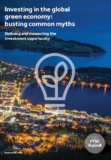
Bron
FTSE Russell
FTSE Russell’s latest green revenues data shows green economy now level pegging with fossil fuels on six per cent of global economy The green economy now represents approximately six per cent of the globe’s entire economy – the same as the global fossil fuel sector. The report uses FTSE Russell’s green revenues data model to calculate that around six per cent of the market capitalisation of global listed companies is derived from the green economy, amounting to an approximate $4tr investment opportunity.
Until now the transition to a sustainable and “green” economy has been a loose concept rather than a defined, investable, industrial system. This lack of definition and data has led to the impression that it is of limited size; small cap dominated; lacking diversification and that investors give up performance in exchange for environmental benefits. However, analysis by FTSE Russell dispels these stereotypes. It finds a large investment opportunity, backed by global efforts to combat climate change and broader environmental challenges. The opportunity is diversified across company size, geography and sector and has delivered outperformance of the global equity market.
Key features of the green economy
Based on FTSE Russell’s calculations:
It’s substantial: The green economy represents 6% of the market capitalization of global listed companies, approximately US$4 trillion. This represents a significant investment opportunity, approximately the same size as the fossil fuel sector.
It’s growing: The green economy proportion of the global market capitalization is growing, while the fossil fuel sector shrinks.
It’s diversified: The green economy is diversified by company size. While small and mid cap companies have a greater green exposure and represent a larger number of green companies the market is by no means small and mid cap dominated; large cap companies represent approximately two thirds of green market capitalization.
It’s multifaceted: The green economy is diversified across ICB Sectors. Industrials are the largest element, followed by Utilities, Technology, Chemicals, and Construction and Materials. This highlights the diverse nature of goods and services addressing environmental challenges.
It’s global: The US is the largest element of the green economy; however Japan and Europe have the highest green exposure. While China is the third largest element of the green economy; its green exposure is underweight but growing rapidly.
It’s outperforming: Green companies have shown outperformance with FTSE Russell’s broadest green indexes outperforming their parent benchmarks over the last five years.3



